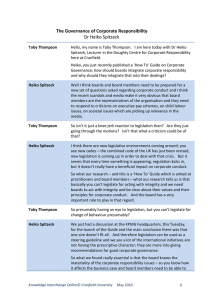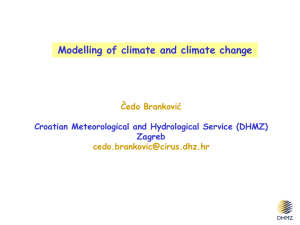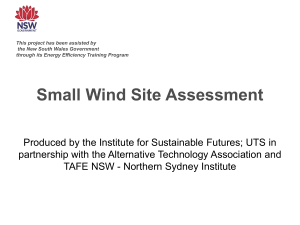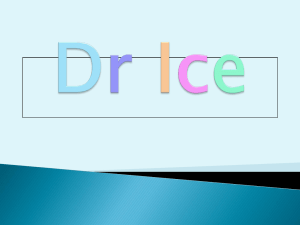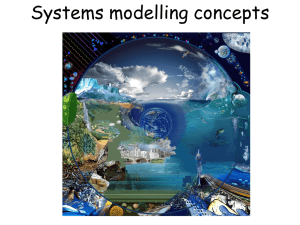Basic mechanisms - COST FP1005 ``Fibre Suspension Flow Modelling`
advertisement
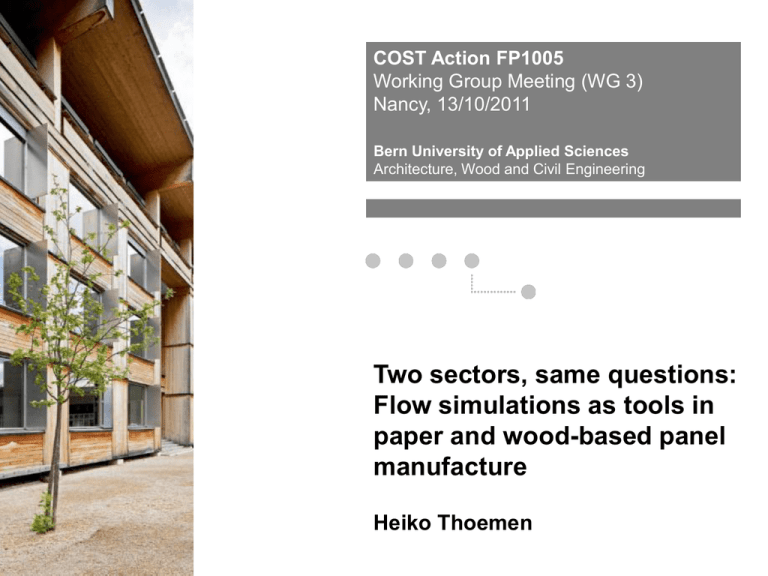
COST Action FP1005 Working Group Meeting (WG 3) Nancy, 13/10/2011 Bern University of Applied Sciences Architecture, Wood and Civil Engineering Two sectors, same questions: Flow simulations as tools in paper and wood-based panel manufacture Heiko Thoemen Bern University of Applied Sciences Architecture, Wood and Civil Engineering Heiko Thoemen COST Action FP1005, 13/10/2011 2 Bern University of Applied Sciences Architecture, Wood and Civil Engineering Education • • • • Higher Technical Schools Bachelor Programs Master Programs Postgraduate Courses Research and development • About 100 full-time equivalent employees • One field of research: Wood-based composites process technology, process modelling Heiko Thoemen COST Action FP1005, 13/10/2011 3 Background of COST project proposal • Considerable similarities between hot-pressing process and calendering of paper sheets – Wood fibers as raw material – Micro-structure of material – Material compression at elevated temperatures – Inhomogeneous cross-sectional density distribution – Moisture content below fiber saturation • Advanced models available in the wood-based composite sector • Important features are missing in today's calendering models – Phase change of water – Convective heat transfer inside the web – Material compaction – Development of cross-sectional density profile Great potential for facilitating synergies and scientific exchange Heiko Thoemen COST Action FP1005, 13/10/2011 4 Motivation for modelling the calendering process • Understand fundamentals of paper calendering • Further improve surface quality without reducing paper or board thickness • Develop strategies to reduce energy consumption Heiko Thoemen COST Action FP1005, 13/10/2011 5 Objective of COST Action FP1005 "Promote and disseminate validated computer modeling and simulation techniques in papermaking industry. These modern numerical tools, allowing for deep insight into the physics of the momentum, mass and heat transfer processes, provide new possibilities for design engineers resulting in innovative solutions unavailable with already utilized methodologies" Memorandum of Understanding, COST Action FP1005 Heiko Thoemen COST Action FP1005, 13/10/2011 6 Content 1. Process comparison 2. Modelling hot pressing of MDF* 3. Model adaptation to calendering * MDF = Medium Density Fiberboard Heiko Thoemen COST Action FP1005, 13/10/2011 7 Calenders (long nip) Shoe calender Process comparison Belt calender Heiko Thoemen COST Action FP1005, 13/10/2011 9 MDF hot press Process comparison Forming line Hot press p Pressure Temperature in heating circuits T Heiko Thoemen COST Action FP1005, 13/10/2011 10 Material structure Process comparison MDF Newsprint Paper Density (kg/m³) 1200 1000 800 600 400 0 5 10 15 20 Cross-sectional position (mm) Source: Christine Antoine et al. (2002). 3D images of paper obtained by phasecontrast X-ray microtomography: image quality and binarisation Heiko Thoemen COST Action FP1005, 13/10/2011 12 Challenging differences Process comparison • Thickness of material • Duration of temperature and pressure exposure • Pre-treatment of paper sheet / fibres before calendering Heiko Thoemen COST Action FP1005, 13/10/2011 13 Content 1. Process comparison 2. Modelling hot pressing of MDF 3. Model adaptation to calendering Heiko Thoemen COST Action FP1005, 13/10/2011 14 Heat and moisture transfer MDF modelling Basic transfer mechanisms Fibre mat Heating platen or steel belt heat conduction > 200°C Heiko Thoemen COST Action FP1005, 13/10/2011 19 Heat and moisture transfer MDF modelling Basic transfer mechanisms heat conduction > 200°C evaporation of water Heiko Thoemen COST Action FP1005, 13/10/2011 20 Heat and moisture transfer MDF modelling Basic transfer mechanisms heat conduction convection > 200°C evaporation of water Heiko Thoemen COST Action FP1005, 13/10/2011 21 Heat and moisture transfer MDF modelling Basic transfer mechanisms condensation of water vapor heat conduction gas and heat convection > 200°C evaporation of water Heiko Thoemen COST Action FP1005, 13/10/2011 22 Rheology MDF modelling Density profile Density Density profile Cross-sectional position Heiko Thoemen COST Action FP1005, 13/10/2011 25 Numerical solution & implementation MDF modelling • Modified finite volume approach (constitutive flux equations are coupled by local energy and mass balances) Gas pressure [kPa] • 3D flow computations, 1D densification model • Implicit approach for cross-sectional flow computations to avoid numerical instabilities • In-house programming code is written in ANSI C • Commercialized as simulation platform Virtual Hot Press 200 30 150 20 100 10 2 0 1 0 Heiko Thoemen COST Action FP1005, 13/10/2011 29 Content 1. Process comparison 2. Modelling hot pressing of MDF 3. Model adaptation to calendering Heiko Thoemen COST Action FP1005, 13/10/2011 33 Selected key assumptions of hot-pressing model Assumption 1: The material is macroscopically homogeneous • Daryc's and Fourier's law, macroscopic flow coefficients • Approach is valid for MDF and even oriented strandboard (OSB), probably also for thick paper and cardboard Assumption will be maintained Heiko Thoemen COST Action FP1005, 13/10/2011 34 Tasks / Working packages 1. Model adaptation 2. Measurement of flow properties • Thermal conductivity • Gas permeability (only in z-direction) 3. Model validation: Measurement of cross-sectional temperature development in thick paper • Will be done at laboratory of Voith Paper (Ravensburg, Germany) • Different paper types 4. Sensitivity analysis Effects of a) material property data and b) process parameters on the heating pattern during paper calendering will be evaluated Heiko Thoemen COST Action FP1005, 13/10/2011 40 Thank You Heiko Thoemen COST Action FP1005, 13/10/2011 42
